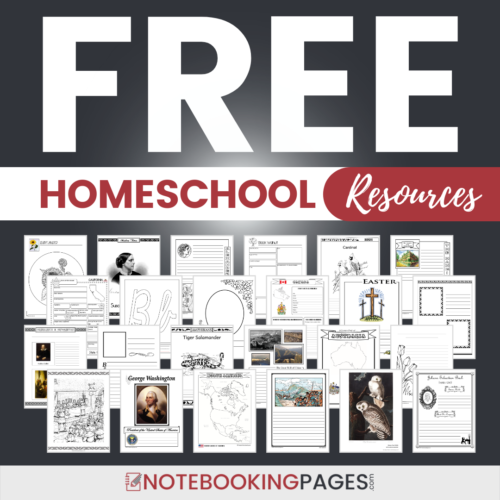Contents
- 1 Homeschooling Lesson Plans in 4 Steps
- 1.1 Lesson Planning Step 1: Determining your school year
- 1.2 Lesson Planning Step 2: Determining your school week
- 1.3 Lesson Planning Step 3: Determining how you’ll divide up the course work
- 1.4 Lesson Planning Step 4: Instructional Lesson Plans
- 1.5 What about objectives and other teacher-thingys?
- 1.6 My take away for you
What is a lesson plan?
Let’s compare a lesson plan to a recipe. If you want to bake a cake, you follow a recipe. The recipe tells you what you need and the steps to follow for a successful bake. The same might be said about a lesson plan. It’s a recipe for success. It’s a plan of action. It tells you what you need and the steps that should be followed. Sounds simple, right? Well, it really is with a little forethought and preparation!
Written by Lynda Ackert of CHSH-Teach.com
What type of planner are you?
There are three types of planners:
- “I need details!” Planner: If you are this type of person, you’ll want (and need) everything planned with extreme detail. So, just do it!
- “I like following plans, I just don’t like creating them.” Planner: If you are this type of person, you like having a ‘road map’ to follow but perhaps you just don’t like taking the time to create it. I’m this type of planner. I like having a plan, I just have to make myself take the time to create it. If this is you, set aside some time and do it.
- “Fly-by-the-seat-of-you-pants” Planner: Isn’t that an oxymoron! (Giggle) That’s okay. If you can plan enough to hold yourself accountable for teaching what should be taught, then you’ll be okay. The main thing is to have goals set and a basic strategy of how and when you’ll be able to accomplish those goals.
Which of these are you? Remember, everyone and every family is different. What works for one homeschooling family will not work for every family. The beautiful thing about homeschooling is that you can design your plans around your family.
Why lesson plan?
Before I begin explaining the ‘how’ of lesson planning, let me first tell you why planning is important.
- Plans help you keep the big picture in sight. They provide you the opportunity to set academic goals for your children.
- Plans help you stay focused when ‘life happens.’ If you have a plan of action and it gets disrupted by daily life, it’s much easier to get ‘back on track’.
- Plans give you a guideline by which you can hold yourself accountable. It can be a quick reference to glance at and ask, “Am I on track to teach what needs to be taught?”
- Plans can make our job easier! Planning may take extra time up front, but it will pay off in the long term. As I previously stated, I’m personally not a detailed planner but when I have a plan I find my mind can relax. I can relax. I can have more fun ‘doing’.
Homeschooling Lesson Plans in 4 Steps
Lesson Planning Step 1: Determining your school year
The first step in creating homeschooling lesson plans is to determine what your school year will look like. Ask yourself these questions:
- Do I have state requirements I must follow?
- Will we homeschool all year or follow a more traditional school schedule?
- What days will we not have school, (holidays, family vacations, etc.)?
- Will I schedule blocks of weeks with a week off in between each block or follow a more traditional schedule taking only holidays and family vacations off?
- What works best for my family?
Once you’ve answered these questions, take a calendar and begin marking. Mark starting and ending days (semesters, blocks, or however you are going to divide up the school year.) Next, mark off any predetermined days off (holidays, vacations, birthdays, etc.). Once you have your calendar set, you are ready for the next step in the process.
Lesson Planning Step 2: Determining your school week
The next step is to determine what your school week will look like. Lay out the year’s course work (curriculum that you have chosen) and ask yourself these questions.
- What courses do I consider the ‘core’ courses? (Typically, these are the 3 R’s: Reading, Writing and Arithmetic)
- What courses will require more work to complete?
- How long can my children stay focused?
- Do I want to teach every course every day? If not, are there courses I should teach daily?
- If I don’t teach every course every day, how many days a week do I want to teach each course?
- Do I want all 5 days a week to be course work or do you want to set aside a day to focus on hands-on learning, field trips, etc.? (I personally always planned 4 days of course work and a day for fun learning experiences away from school books. Once my son began 7th grade, these days were often research and independent project days. It really worked well for us!)
- When will our day begin? When will it end?
- Do I want to incorporate daily living skills (chores, housecleaning, ect.) into the school day to break up course work? (For our family, it was always easiest to start the day with light housekeeping – i.e. bed making, etc., and then place a small break in the afternoon for chores. Also, don’t forget to schedule some recess time in there as well.)
- What extra-curricular activities will be happening throughout the week? (For us, it was always things like dance and music classes with seasonal sports thrown in the mix. Don’t forget that these types of outside activities can be used for P.E. and Fine Arts credits!)
Once you’ve answered these questions, take out a weekly calendar and mark out your school day. When it will begin, when will it end and everything in between. Will you teach Reading first or Math? Plan your entire day based on what you have determined will work best for your family.
Also, try to rid yourself of predetermined ideas of what ‘school’ looks like. If you were a public school student yourself, the homeschool day doesn’t need to look like a typical public school day.
Lesson Planning Step 3: Determining how you’ll divide up the course work
Once you have an idea of what each day will look like on a weekly calendar, look at each course and see how much material there is to cover. Ask yourself these questions:
- How many chapters are there?
- How long will it take to cover each chapter? Include introduction to new skills, teaching new skills, practicing the skills, reviewing and testing.
- If I don’t think I can cover every chapter, what chapters do I feel aren’t vital to the course and can be cut? (Let’s be honest, very few classrooms (public or private schools) finish the entire textbook despite efforts to do so. I was an elementary teacher in the public school system prior to becoming a homeschooling mom…and I know this firsthand!)
Once you’ve determined what should or can be covered, begin doing a basic timeline of chapters using paper, pencil and a calendar or you can simply photocopy the table of contents and write out your timeline on it. Do this for each course that you are planning to teach.
Once this is all done, you’ve completed what I call the ‘Year at a Glance’ plan. It is best to have this complete before the school year begins. It will be your guide to the entire school year and will make creating your instructional lesson planning much easier.
Lesson Planning Step 4: Instructional Lesson Plans
The final step in creating your homeschooling lesson plans. Instructional lesson plans are those that detail what will be done day by day. Since you’ve already decided how your week will be divided up (i.e. what subjects you want to teach on what days and how your day is divided up in time), creating an instructional lesson plan will be more like plugging everything in.
Looking at each day on your weekly planning calendar, start ‘plugging in’ each lesson…
Reading: “Chapter 3” pgs 1-19
Introduce new vocabulary words
Write out words with definitions
Spelling: Create sentences using each
Science: “Magnets – Chapter 2” Read pgs 1-7
Complete experiment pg 8
Materials needed: (nail, paper clips, copper wire)
Suggestion: When planning each week, take time to think about other materials you’d like to use (other than the basic curriculum) such as trade books, board games, DVDs, kits, etc. and write these in your plans. At the beginning of every week, you’ll be able to, at a glance, know what materials to have on hand for the week.
Your instructional lesson plans can be as detailed as you feel necessary and can be written on a weekly lesson planning chart, a daily planning chart or even index cards. Whatever works best for you!
You can create your plans for a week at a time or for a longer period (a month, a semester or even the entire year). If this is your first year of homeschooling, I suggest that you do a month at first and see how it works. If you feel that you are planning too much, not enough or you simply need to change your planning style, it is easy to do so the next month.
What about objectives and other teacher-thingys?
As I previously mentioned, I was a public school teach before becoming a homeschooling mom. When I was teaching in the school system, we were required to complete long and lengthy lesson plans. Since I’m not a very detailed planner, I hated writing lesson plans. In the school system, I not only had to list objectives for each lesson, I had to use key words from Bloom’s taxonomy throughout. This is NOT necessary for homeschool planning.
- The Purpose of Objectives
Objectives have a purpose in the school system because teachers need to show that they understand what they are teaching, why they are teaching it and then (above all) expressing this to administrators.Most packaged curriculum sets that you purchase will have objectives throughout the teacher’s manuals. It’s great to read these but there is no reason for you to worry about creating your own. Even if you are piecemealing your curriculum together yourself, don’t worry about writing objectives. - What is Bloom’s Taxonomy
Bloom’s taxonomy is simply a list of verbs used to describe the type of outcomes students will be expected to achieve throughout a lesson based on distinct types of learning (cognitive, emotional and sensory). Do I believe you need to worry about Bloom’s when completing your homeschooling lesson plans? No.
I do think having Bloom’s taxonomy as a reference would be helpful tool just to keep around. Reading over it can help you think of the many diverse ways to engage your children. However, don’t ever, ever think you are not a good teacher if you do not write ‘teacher’ like lesson plans. This is simply not the case.
My take away for you
Over the last twenty years, I’ve had moms coming to me saying they wanted to homeschool but didn’t think they could. When I’d ask them why, often the answer would be, “I’m not organized enough.” Let me put this to rest! You don’t have to be a perfect, detail planning parent to be a good teacher!
There is a need for planning but if you are able to maintain your household (put a list together for grocery shopping, keep track of your kids and their extra-curricular activities and can follow a recipe to make your favorite meal), you have the skills necessary to do the amount of planning it takes to put together homeschooling lesson plans that work for your family!
Remember, lesson planning is nothing more than creating a recipe to teach what you are going to teach and when. That’s it. The amount of detail that goes into it is up to you. It’s simply a plan. That’s it.
If you’ve never planned lessons before, it can take practice but over time you’ll learn what works and what doesn’t along the way. It’s all part of the journey…and what a wonderful journey it is!!
What are your best tips for creating homeschooling lesson plans?
This is day 19 of my Homeschooling 101 Series. Don’t forget to enter the giveaway (ends 5/5/19) and join the exclusive Facebook group to chat it up with our bloggers, ask questions and just be a part of our amazing and growing community!
For more homeschooling inspiration, tips and encouragement, make sure to follow KFH on Facebook, Pinterest, Instagram and Twitter, and subscribe to our Newsletter for some FREE GOODIES!
CHSH-Teach.com was created in 2010 by Lynda Ackert, a Christian wife, mother and veteran educator of 20+ years. She began her career as a public school teacher and taught both in the states and overseas for the Department of Defense before becoming a mother at the age of 33. It was at that time she began homeschooling. As part of her passion for teaching, she discovered her love for creating educational materials for teachers and homeschoolers and has chosen to give back to the educational community through her efforts to create and maintain this community.






Thank you so much for these wonderful and common sense techniques for planning. I have been on the fence about starting our second year of homeschooling. You really put it in perspective and gave me the tools to make this a productive and fun year. Blessings to you and your family.